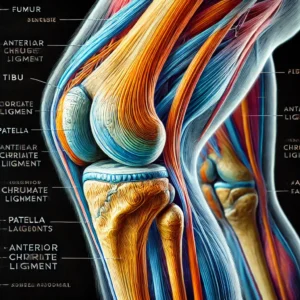Keys to Early Phase ACL Rehabilitation
 ACL rehab is crucial in the anterior cruciate ligament – one of the most crucial structures in the knee, responsible for maintaining stability and preventing excessive motion between the femur and tibia. Injuries to the ACL, often caused by sports activities or accidents, are common and can be a significant setback for active individuals. While surgical intervention is sometimes necessary, a critical part of recovery involves the rehabilitation process. The early phases of ACL rehabilitation are especially important because they lay the groundwork for a successful recovery and return to function. Proper care, techniques, and goals in these initial stages can make a profound difference in the long-term outcomes for the patient.
ACL rehab is crucial in the anterior cruciate ligament – one of the most crucial structures in the knee, responsible for maintaining stability and preventing excessive motion between the femur and tibia. Injuries to the ACL, often caused by sports activities or accidents, are common and can be a significant setback for active individuals. While surgical intervention is sometimes necessary, a critical part of recovery involves the rehabilitation process. The early phases of ACL rehabilitation are especially important because they lay the groundwork for a successful recovery and return to function. Proper care, techniques, and goals in these initial stages can make a profound difference in the long-term outcomes for the patient.
In this blog post, we’ll explore the keys to successful ACL rehabilitation in its early phases, emphasizing the importance of setting a strong foundation for recovery, restoring function, and preventing complications.
1. Focus on Restoring Range of Motion (ROM)
In the immediate aftermath of ACL surgery or injury, the priority is often to restore the knee’s range of motion (ROM). Post-surgical swelling and pain can limit the knee’s ability to fully extend or flex, which can significantly affect the overall function of the leg. Without proper ROM, the knee will not be able to move smoothly, limiting the effectiveness of subsequent rehabilitation exercises.
Why is ROM so important?
A lack of ROM can result in joint stiffness, which can complicate rehabilitation and make it more difficult to progress to strength-building exercises in later phases. Therefore, early efforts should focus on achieving full extension and gradually improving flexion, which is crucial for everyday movements like walking, climbing stairs, and squatting.
2. Managing Swelling and Inflammation
Swelling and inflammation are common following an ACL injury or surgery. While some level of swelling is expected, it must be managed carefully to ensure optimal healing conditions. Excessive swelling can impede circulation and reduce the knee’s ability to heal effectively, delaying rehabilitation progress.
What are some key strategies for swelling management?
- Elevation: Keeping the knee elevated above heart level can help reduce swelling by encouraging fluid to flow away from the injury site.
- Ice: Applying ice in the first few days following surgery or injury can help manage both swelling and pain. Cold therapy should be applied intermittently, typically for 15-20 minutes every 1-2 hours in the first 48 hours post-injury.
- Compression: Using a compression bandage or knee sleeve can assist in reducing swelling and stabilizing the knee.
Additionally, it’s essential to monitor for signs of excessive swelling, as it could indicate infection or complications that may require medical attention.
3. Pain Management
Pain is a natural part of the recovery process, but it should be managed appropriately to prevent excessive discomfort that could hinder rehabilitation. In the early stages of recovery, patients often experience pain from surgical incisions, inflammation, and the trauma of the injury itself.
How can pain be controlled?
- Medication: Prescription pain medication or over-the-counter pain relievers can help manage pain in the early stages. Non-steroidal anti-inflammatory drugs (NSAIDs) are commonly recommended, but it’s important to follow the doctor’s guidance on when and how to take them to avoid complications.
- Therapeutic modalities: Modalities like heat therapy or transcutaneous electrical nerve stimulation (TENS) can be used to manage pain and promote relaxation in the muscles surrounding the knee.
Pain management in the early phases is not just about comfort; it also plays a crucial role in maintaining compliance with rehabilitation protocols. If the patient is in too much pain to complete exercises, it can delay progress and increase the risk of developing compensatory movement patterns that might lead to long-term dysfunction.
4. Early Strengthening Exercises
Strengthening the muscles around the knee, particularly the quadriceps and hamstrings, is crucial for ACL rehabilitation. These muscles help to support the knee joint and reduce the load placed on the ACL during movement. However, strengthening exercises must be carefully implemented during the early phases of rehabilitation to avoid placing too much strain on the healing ACL.
What type of exercises are appropriate early on?
In the initial stages, the focus should be on isometric exercises that activate the muscles without requiring joint movement. Examples include:
- Quad sets: This exercise helps activate the quadriceps and reduce atrophy, which is common after an injury.
- Hamstring sets: By contracting the hamstrings, this exercise helps to maintain muscle engagement.
- Straight leg raises: This simple exercise targets the quadriceps without requiring significant knee motion.
As the patient progresses, more dynamic exercises like leg presses and knee extensions can be introduced, but these should be done with caution to ensure the ACL is not stressed too early.
5. Proprioception and Neuromuscular Re-education
 One of the most critical aspects of ACL rehabilitation is restoring proprioception— the body’s ability to sense the position and movement of the knee joint. After an ACL injury or surgery, proprioceptive ability is impaired, which can lead to instability and an increased risk of re-injury.
One of the most critical aspects of ACL rehabilitation is restoring proprioception— the body’s ability to sense the position and movement of the knee joint. After an ACL injury or surgery, proprioceptive ability is impaired, which can lead to instability and an increased risk of re-injury.
How can proprioception be trained early on?
- Balance exercises: Simple exercises such as standing on one leg or using a balance board can challenge the nervous system to regain its sense of joint position.
- Joint mobilizations: Physical therapists can use manual techniques to help the knee joint move in a controlled way, which enhances joint proprioception.
The goal is to reestablish neuromuscular control of the knee so that the patient can regain safe movement patterns as they transition back to more dynamic activity.
6. Patient Education and Psychological Support
The early rehabilitation phases can be frustrating for patients. There are often limitations on mobility, and progress may seem slow. Patient education is crucial at this stage to manage expectations and encourage adherence to the rehabilitation plan.
What should be included in education?
- The importance of rest and proper rehabilitation to prevent reinjury.
- Techniques for pacing recovery and avoiding overexertion.
- Information on the timeline of rehabilitation, including what to expect in future phases.
Psychological support, such as counseling or motivational support, can also help patients stay positive and committed to their recovery goals.
Conclusion
Rehabilitation after an ACL injury or surgery is a journey that requires patience, dedication, and careful planning. The early phases of ACL rehabilitation are particularly important because they establish the foundation for long-term recovery. Focusing on restoring range of motion, managing swelling and pain, performing early strengthening exercises, and improving proprioception can significantly improve the outcome of the recovery process. Working closely with physical therapists and healthcare providers during this stage ensures that patients progress safely and effectively, reducing the risk of setbacks and preparing them for the more intense rehabilitation phases that follow.
